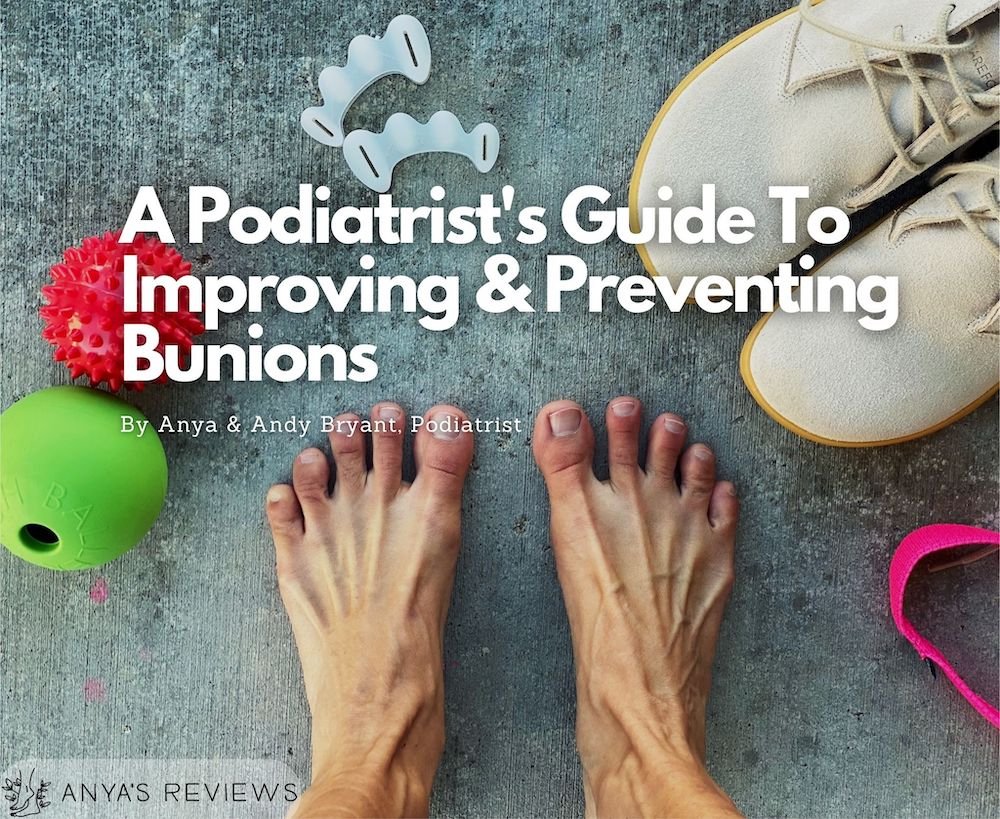
Written in collaboration with Andy Bryant, Podiatrist.
Bunions can be a real nuisance. But there’s quite a lot that can be done about them! Whether it’s the pain, the dysfunction, or the look of the bunion that is bothering you, there are practical steps to improve the condition without the aid of surgery.
We’re talking about more than ice & rest here. But we’re also not making empty promises of miraculous cures. This is a podiatrist’s guide to actually improving your bunions by getting at the underlying issues.
Got bunion pain? Let’s take a dive.
What Is A Bunion?
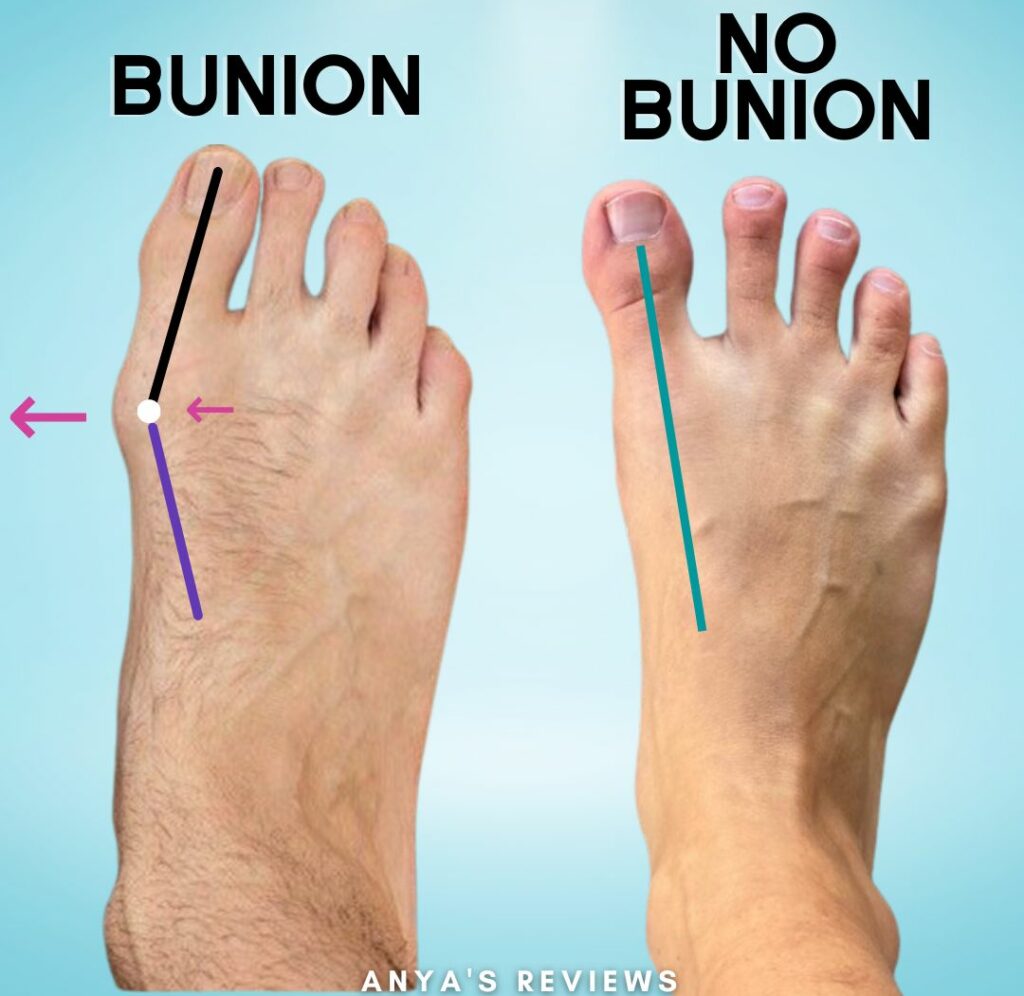
Contrary to popular belief, a bunion is not a growth on the outside of your toe joint. A bunion (aka hallux valgus) is actually a misalignment of the foot. The joint at the base of the big toe – or sometimes little toe – moves away from the foot, causing the head of the bone to protrude out to the side and the toes to angle inward.
The more those joints move out of alignment, the more the head of the bone protrudes – giving your foot that classic bunion shape. No growth, just protruding bone. Ouch!
A foot with a bunion is widest at the base of the toes. By contrast, a natural foot shape is widest at the tips of the toes.
So how does one get a bunion to begin with?
What Causes a Bunion?
The root cause of bunions is multifactorial. This means there are likely multiple overlapping reasons you have a bunion.
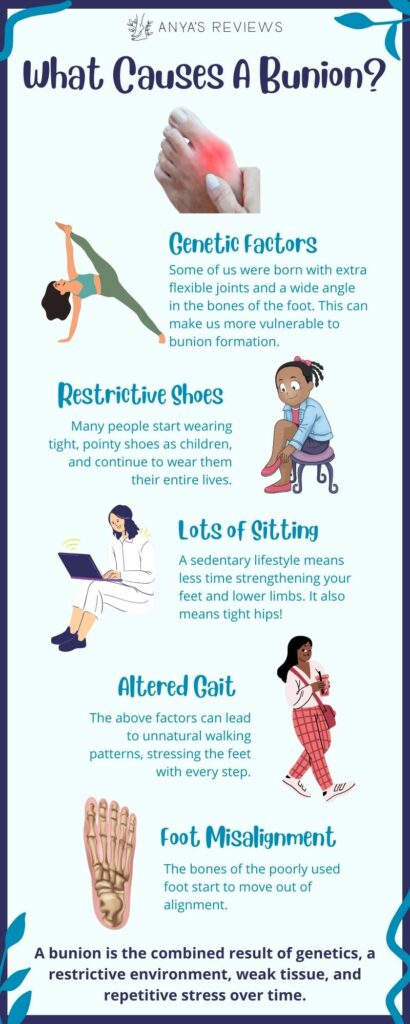
Do Genetics Cause Bunions?
Traditionally bunions have been blamed entirely on genetics, but we’re starting to see that the environment our feet are in (and the body they’re attached to!) has a large effect on the formation of bunions.
Even still, there are two genetic factors worth noting that Dr. Andy sees implicated in the formation of bunions.
- A wide intermetatarsal angle – This is a foot type you can be born with where there’s a wider than usual angle between the 1st and 2nd bones of the foot. Bunions are more common in those with a wide angle and less in those with the bones closer to parallel.
- Joint flexibility – You are more likely to have a bunion if you have very flexible joints, both locally at the foot and in general throughout the body (hypermobility). Women tend to have more joint flexibility than men, which is one possible reason bunions are more common in women than men.
But these factors do not dictate whether or not you will have bunions! Many people who are genetically predisposed never have bunions, and many people who aren’t predisposed do have bunions. You can’t control your genetics, but you can control your environment.
Does Lifestyle Cause Bunions?
Despite the fact that there are genetic factors that can predispose you to bunions, the reality is our lifestyle choices have a tremendous impact on our foot health.
Factors such as how strong and dynamic our core is, how multi-dimensional our movement patterns are, and – perhaps most importantly – the shoes we wear daily, can all influence whether or not we develop bunions.
Does Footwear Cause Bunions?
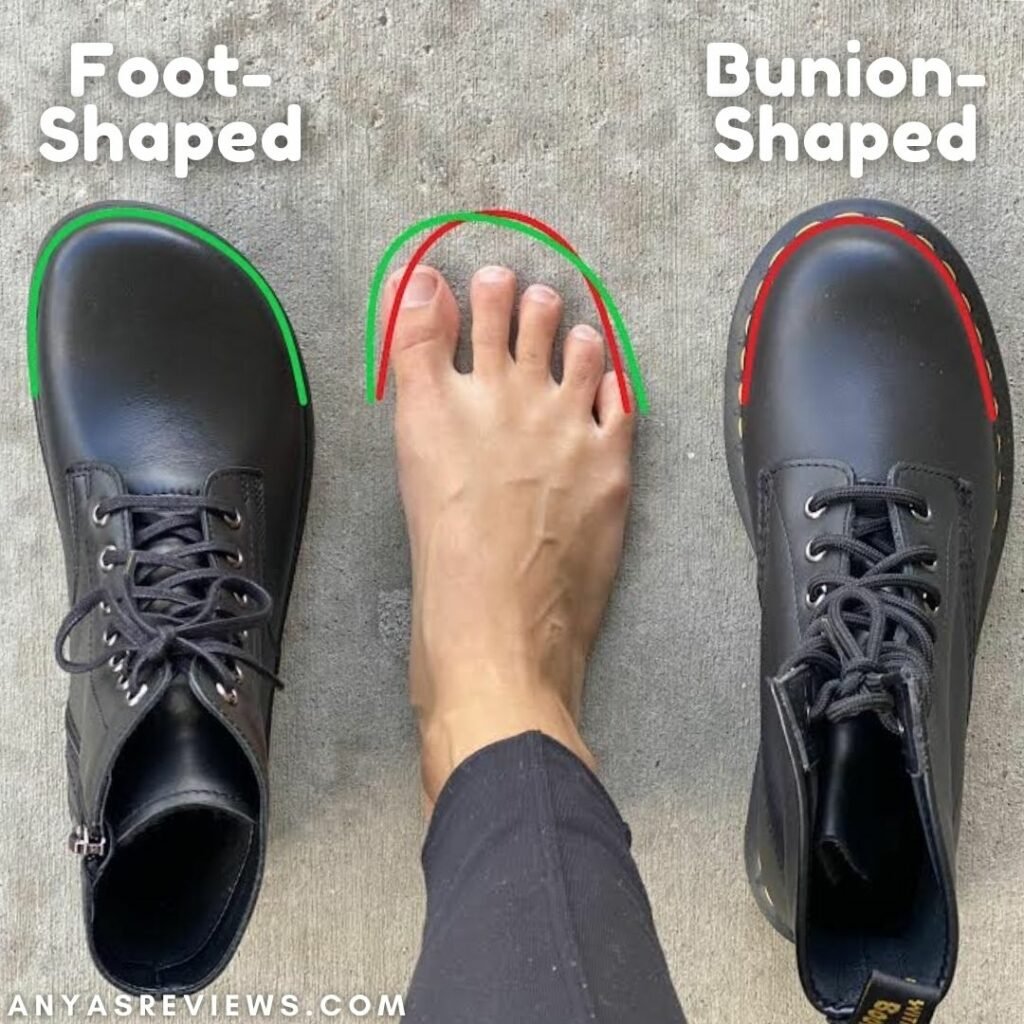
If you live in a shoe-wearing culture you likely have had your feet housed in shoes for most of your life. And unfortunately most shoes today are widest at the ball of the foot and then taper toward the toes – the exact shape of a foot with a bunion! So is it all that surprising that so many of our feet match the shape of the shoes we wear every day?
We know that bodies can be morphed and changed by external stimulus – think foot binding, ear gauges, neck rings, and corsets. Combine a foot corset (aka restrictive shoe) for hours on end with a genetic predisposition for bunions, and a bunion may very well be the result.
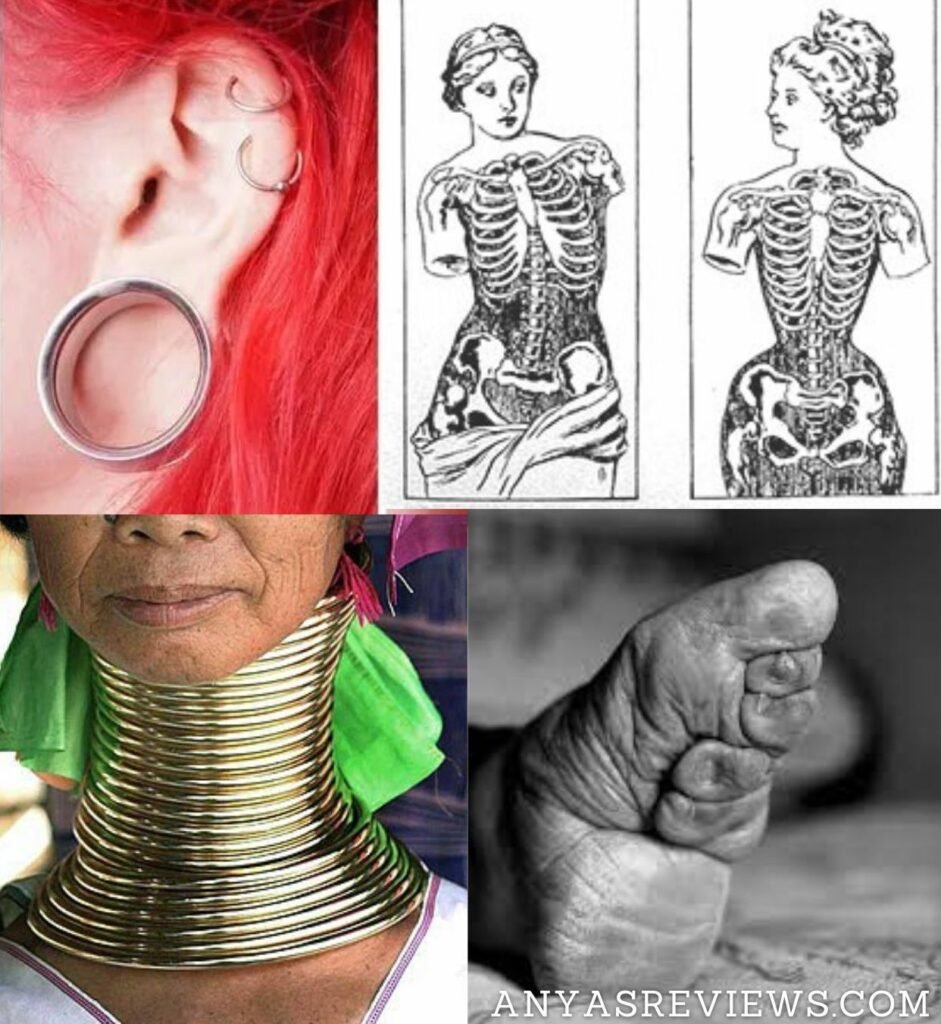
And because we rarely see bunions in populations that don’t wear shoes, it makes sense to consider our footwear. Pointy fashion shoes might be another reason we see bunions more frequently in women than men.
Will Barefoot Shoes Fix My Bunions?
So if I stop wearing pointy-toed shoes and start wearing foot-shaped shoes, my bunions will go away? Not exactly! Barefoot shoes have a natural foot shape to them that doesn’t squish the toes, and Andy has seen numerous cases of bunions improving over time simply by switching to this type of footwear. But unfortunately “fixing” a bunion is not often so straightforward.
When the big or little toe joint changes its position to form a bunion, the muscles, tendons and ligaments in the area also change. They might get tighter, weaker, stronger, or looser. So addressing these soft tissue changes alongside better footwear and lifestyle choices is a more holistic approach to improving your bunions.
What To Do About Your Bunion
As a podiatrist, Andy works with people affected by bunions everyday. And he has seen many of them reduce their pain, restore function, and even sometimes completely reverse the bunion (both in the big and little toe) through the steps laid out below. The degree to which you can improve your bunion varies from person to person, but if you’d like to avoid surgery this is where you start (and we’d recommend starting sooner rather than later).
Please note that surgery is always an option – but let it be the last option. Bunion surgery is a big deal, and giving rehabilitation a proper chance can bring so much relief that you might be able to completely avoid surgery. If you do end up with bunion surgery you will still benefit from the recommendations here as you will have healthier feet going in and better results coming out.
Here is how Dr. Andy treats patients with bunions:
Foot Shaped Footwear

While we’ve already established that footwear is not the end-all-be-all for bunions, it cannot be understated that shoes must be part of the discussion. If you want to give your foot a chance to realign itself (and you wear shoes for long periods of time), those shoes need to have space for the big toe to lay straight.
All the exercises and support in the world won’t be enough if we put a foot with a bunion back into a pointy, tapered shoe all day everyday. So step 1 is to wear anatomically shaped shoes.
But it’s common for people with bunions to have limited range of motion in their big toe – or little toe – , which can make it difficult to wear flexible barefoot shoes. You don’t want to aggravate your already painful feet, so you may want to start with a wide toe box shoe that has some cushion and support while you work on your foot function (as laid out in this article).
Over time you may be able to wear more minimal shoes as you regain function in your feet! Here are some guides to shoe buying to help get you started:
- Foot-shaped, but not barefoot shoes
- Beginner barefoot shoes (with cushion)
- Insoles to wear with barefoot shoes
- Finding shoes for your foot type
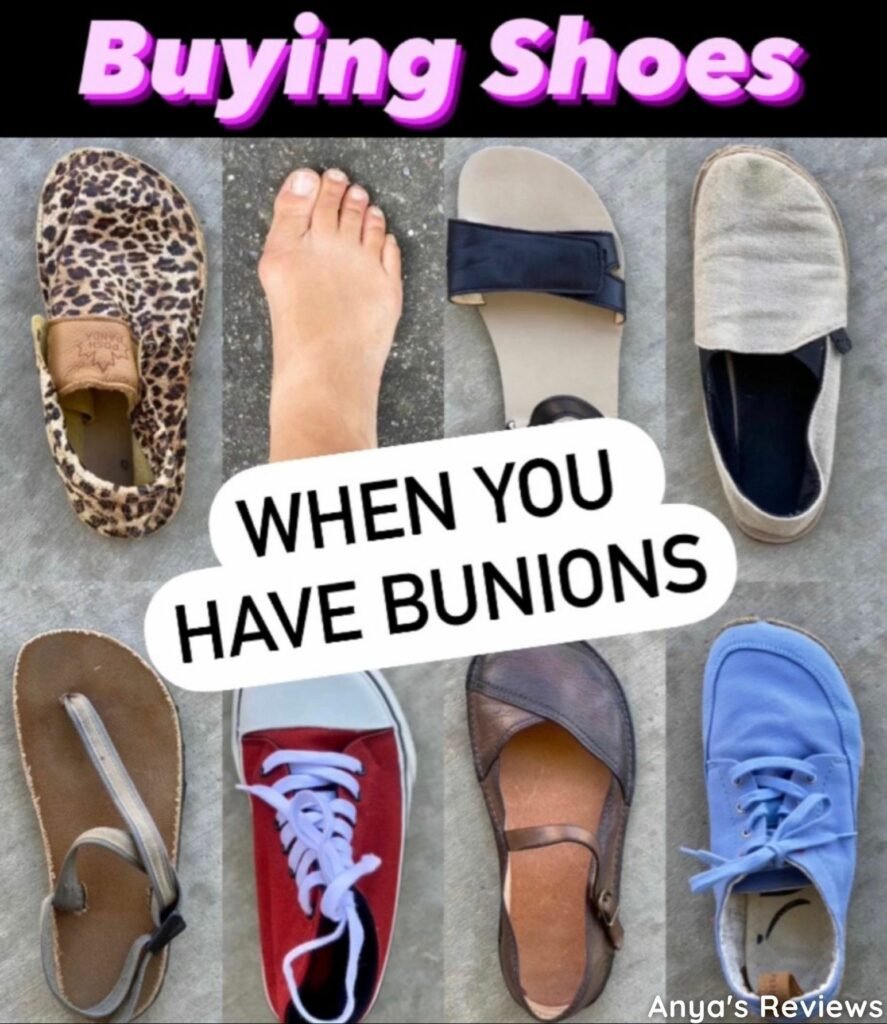
It’s worth noting that at first “foot-shaped” shoes might have more space than you can fill, because bunions cause your toes to compress together. So consider your new pair of shoes as aspirational – you need to stop squishing your feet and provide an opportunity for your toes to spread out. Over time your toes likely will start filling up the shoe, especially if you use toe spacers with them.
Toe Spacers
Another low hanging fruit when it comes to improving bunions is toe spacers. Toe spacers can help realign the foot and are easy to add to your life. They’re the opposite of squishy footwear – instead of compressing your toes together, toe spacers coax them apart.
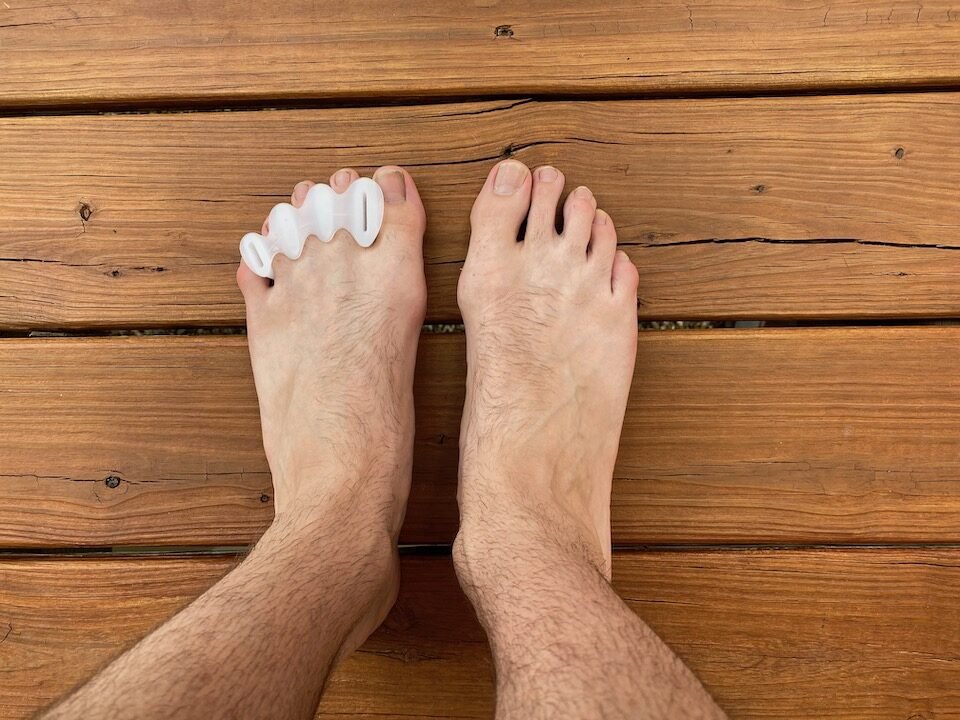
There are many different types of toe spacers. We like Correct Toes best because they are adjustable, come in 4 sizes for different shaped feet, and you can wear them all day – even inside shoes and while exercising.
There are also many one-size-fits-all spacers available, such as these from The Toe Spacer. But those tend to spread the toes more aggressively and are not as easily worn all day as Correct Toes. They work best for average sized feet, and for shorter periods of time. The upside is that these spacers are fairly cheap, so might be a more accessible starting point.
If your bunions are severe enough that these full foot spacers are hard to tolerate, a single spacer can be used between the 1st and 2nd toes. You can also modify the above spacers to fit your foot by cutting portions off.
Read more on the benefits of toe spacers in this article.
Mobilize The Toes & Foot
Now is where you have to put in a little elbow grease, because mobility in the joints is necessary if you want to see a change in your foot alignment. Not only will it improve the bunion, but it also is necessary for your foot to do its job of absorbing impact and propelling you forward (and improving this function will help you be more comfortable barefoot or in barefoot shoes).
In particular, the big toe joint needs 60-70 degrees of bend to function properly. Bunions are often stiff and that amount of flexion might be really difficult! Here are some ways you can improve the mobility of your foot.
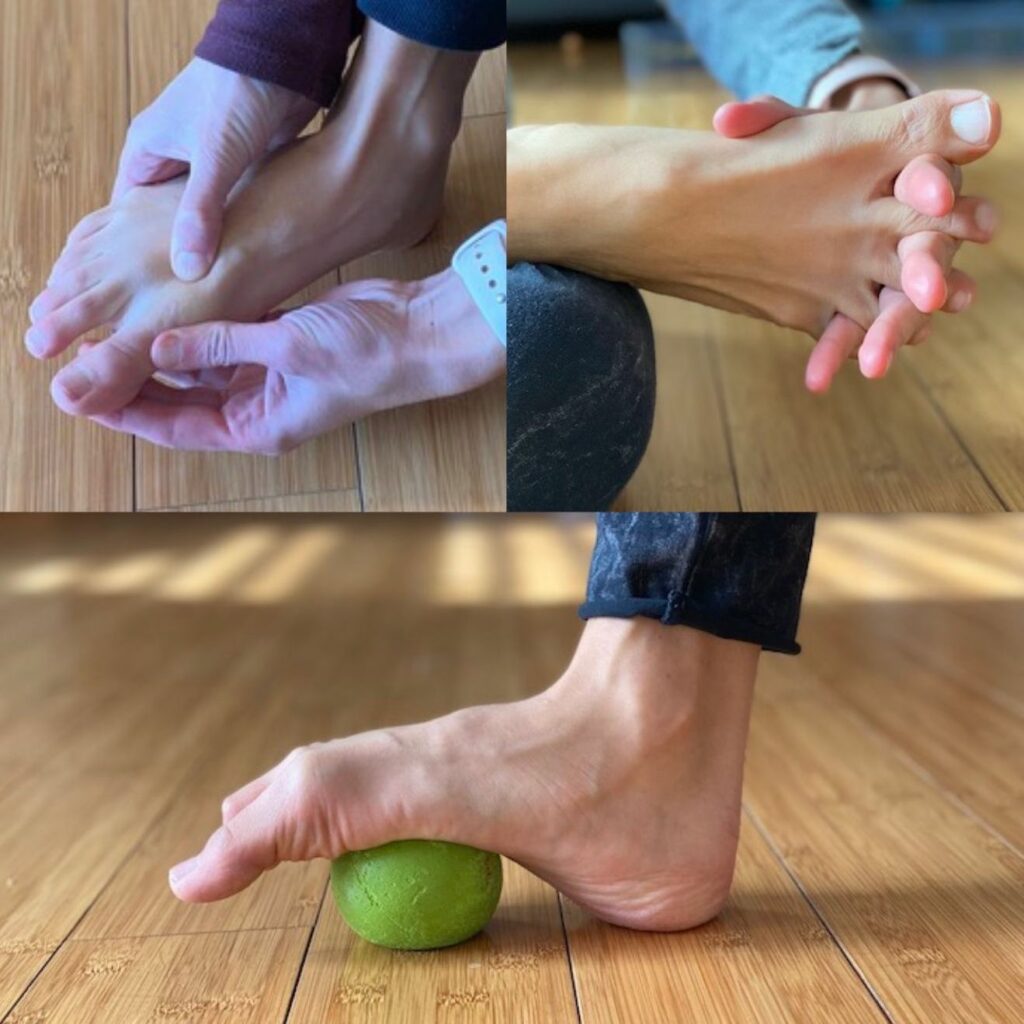
- Self massage – This simple technique is surprisingly effective.
- Rolling over a ball – You can apply pressure under the bunion and the entire foot.
- Wearing flexible shoes – So you get natural motion of your foot throughout your day (barefoot shoes are flexible!).
- Walking barefoot on uneven surfaces.
Strengthen The Toes & Foot
Just as with any other muscle in the body, our foot muscles can be strengthened by loading them.
Mobility in the joints makes it possible for your bunion to move back into alignment, while strength in the joints helps increase the stability needed for them to stay in alignment. The fun thing about foot exercises is a lot of them both mobilize AND strengthen!
Here are a few of our favorites
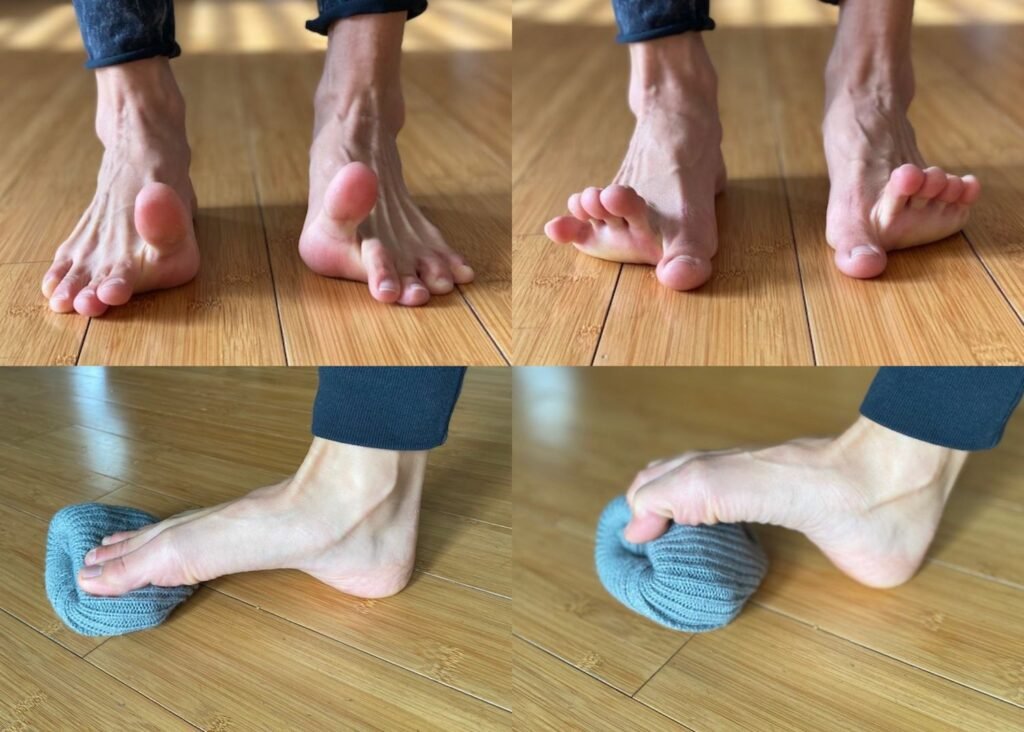
- Toe yoga – keep the heel planted and isolate the movement of your big toe and outer toes by lifting them individually.
- Toe grabs – place a hacky sack or towel, under the ball of your foot and pull it toward you and then away from you using only your toes (heel planted).
- Toe squeezes – place a ball under your big toe and squeeze down on it for 15 seconds. Then lift the big toe away from the ball and hold for 15 seconds. You can do the same exercise with the the ball under your outer toes.
In general you want to do each exercise for 2-3 minutes on each side, or until fatigue/cramping. It’s very likely this will feel challenging at first, even frustrating! It’s ok if your movements are small at first – keep at it and watch your progress!
Read more about exercises to strengthen your feet here.
You can also improve the health of your feet by strengthening your ankles, calves, and shins. That means that being more physically active in almost any way will help your feet too.
Check out these free resources from Whealth for strengthening for feet, knees, hip, & more!
Strengthen The Ankle
When the ankle is strong and capable, it can relieve pressure on the foot and improve your overall gait. Because bunion development is related to foot dysfunction, better ankle health can improve your bunion. And ankle exercises are almost always foot strengthening exercises too!
Here are some easy ways to strengthen your ankles:

- Balancing – walk on a balance beam or other uneven surfaces
- Calf raises
- Jumping rope barefoot
- Single leg deadlift
Mobilize & Strengthen the Hips
The hip has a direct connection with the functioning of your foot – that is why people with stiff, immobile hips often have dysfunction in their feet. Living a movement rich and variable lifestyle is one of the best ways to keep your hips mobile and strong. Don’t underestimate how much it can impact your foot health!
Our favorite way to improve the strength and mobility of your hips is to sit on the floor. Ditching the chair and opting for squatting and as many different sitting positions as possible can work wonders. We also recommend taking movement breaks regularly to break up your sitting. If you want to more intentional hip work, CARS are a fabulous exercise!
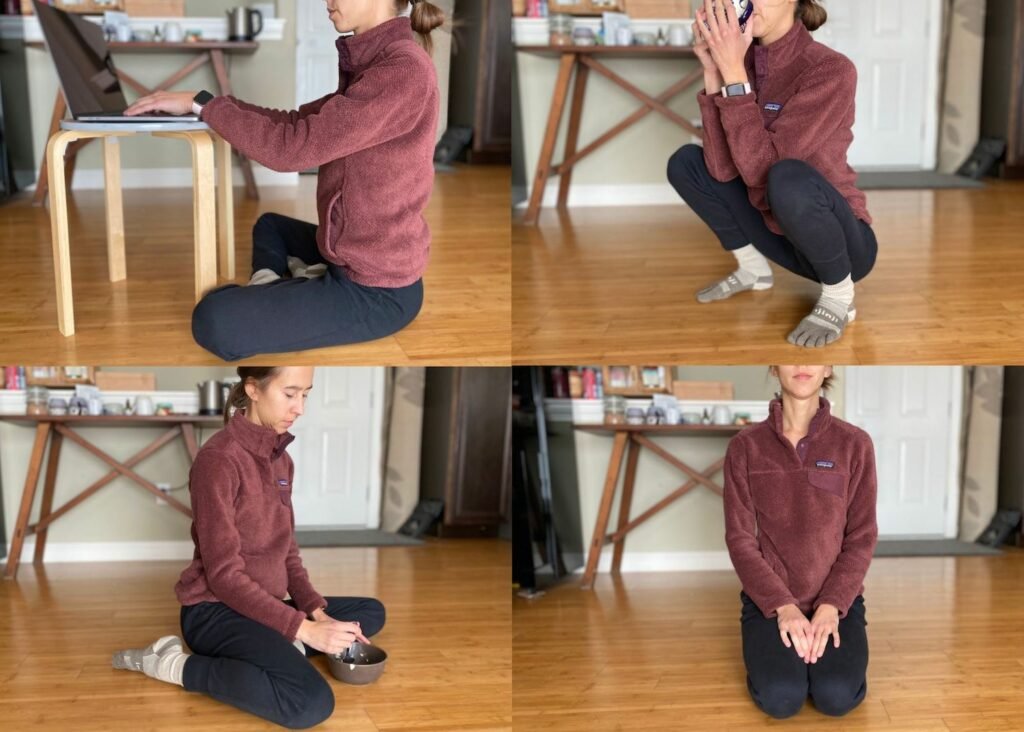
Bunion Before & After
You can see here examples of people who have changed their footwear and worked on their foot function to improve their bunion. These changes vary from person to person, and often take a long time to become evident. But we have seen over and over that change is possible! And even if your bunion doesn’t visibly change shape, natural foot care can prevent further damage and reduce pain & inflammation.
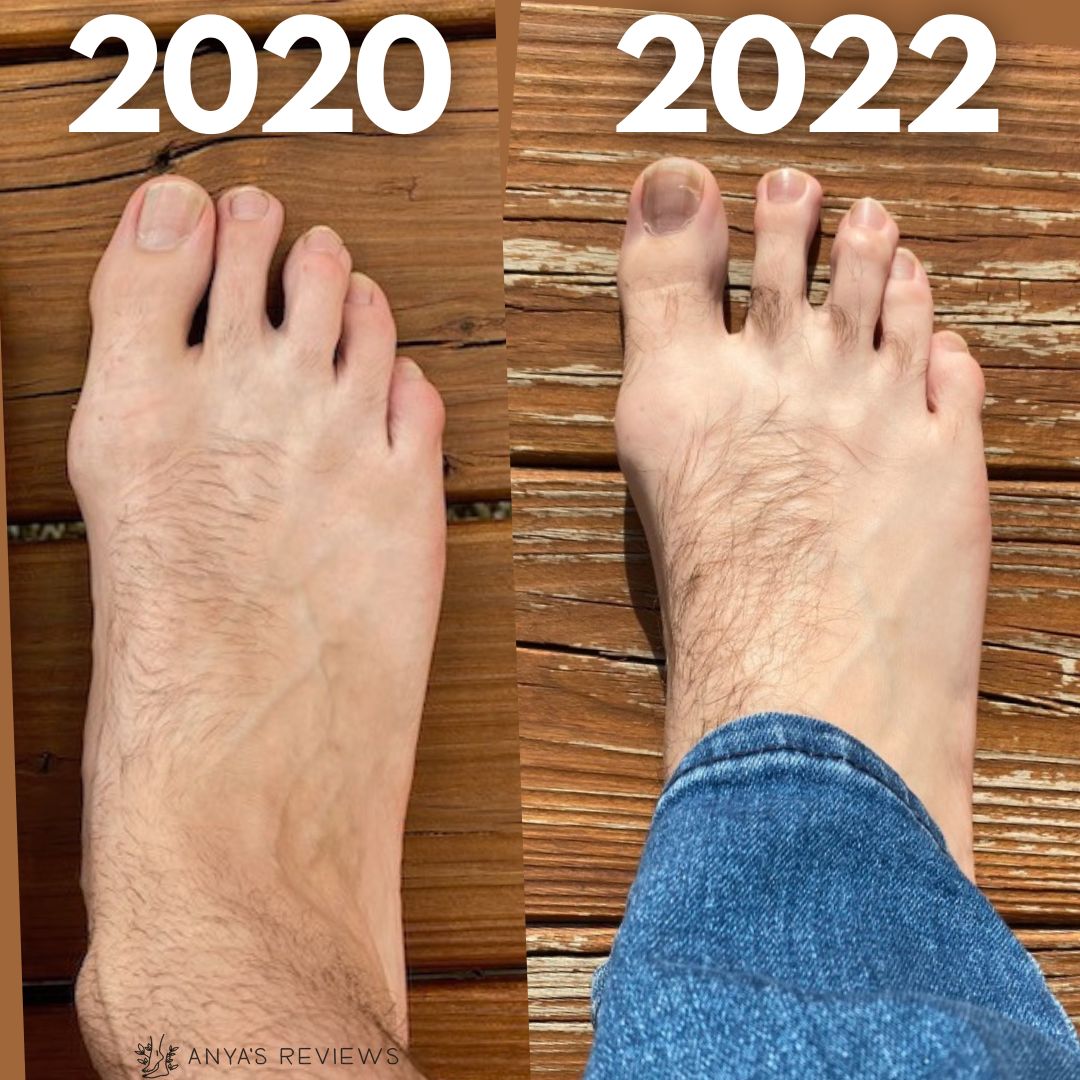
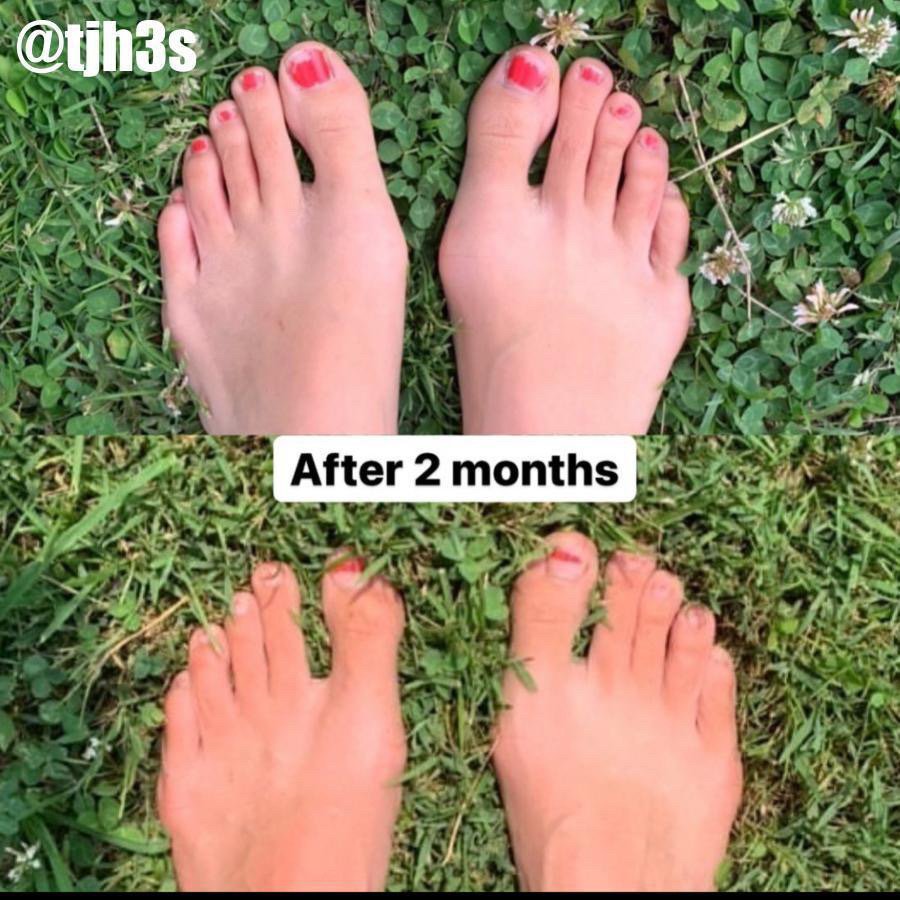
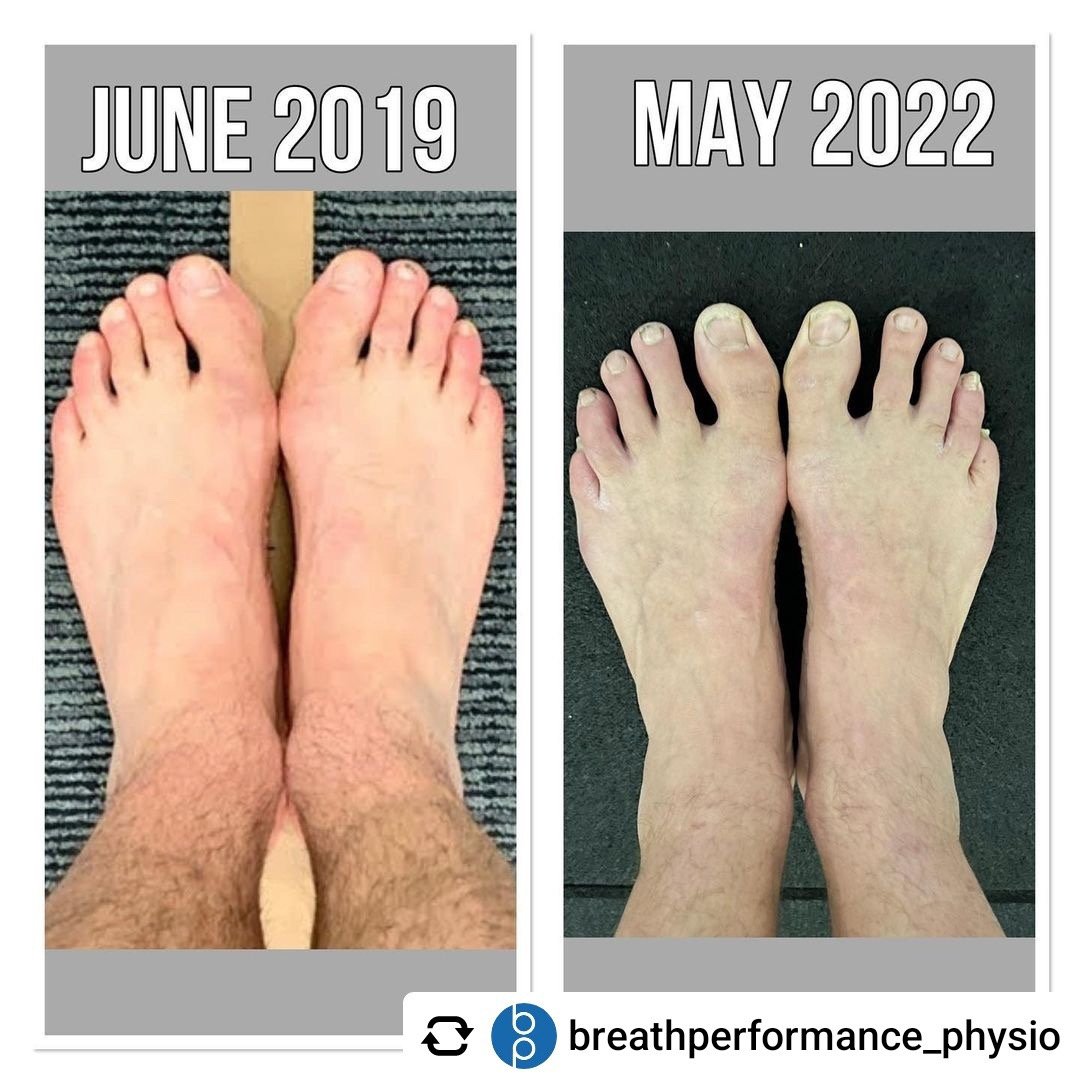
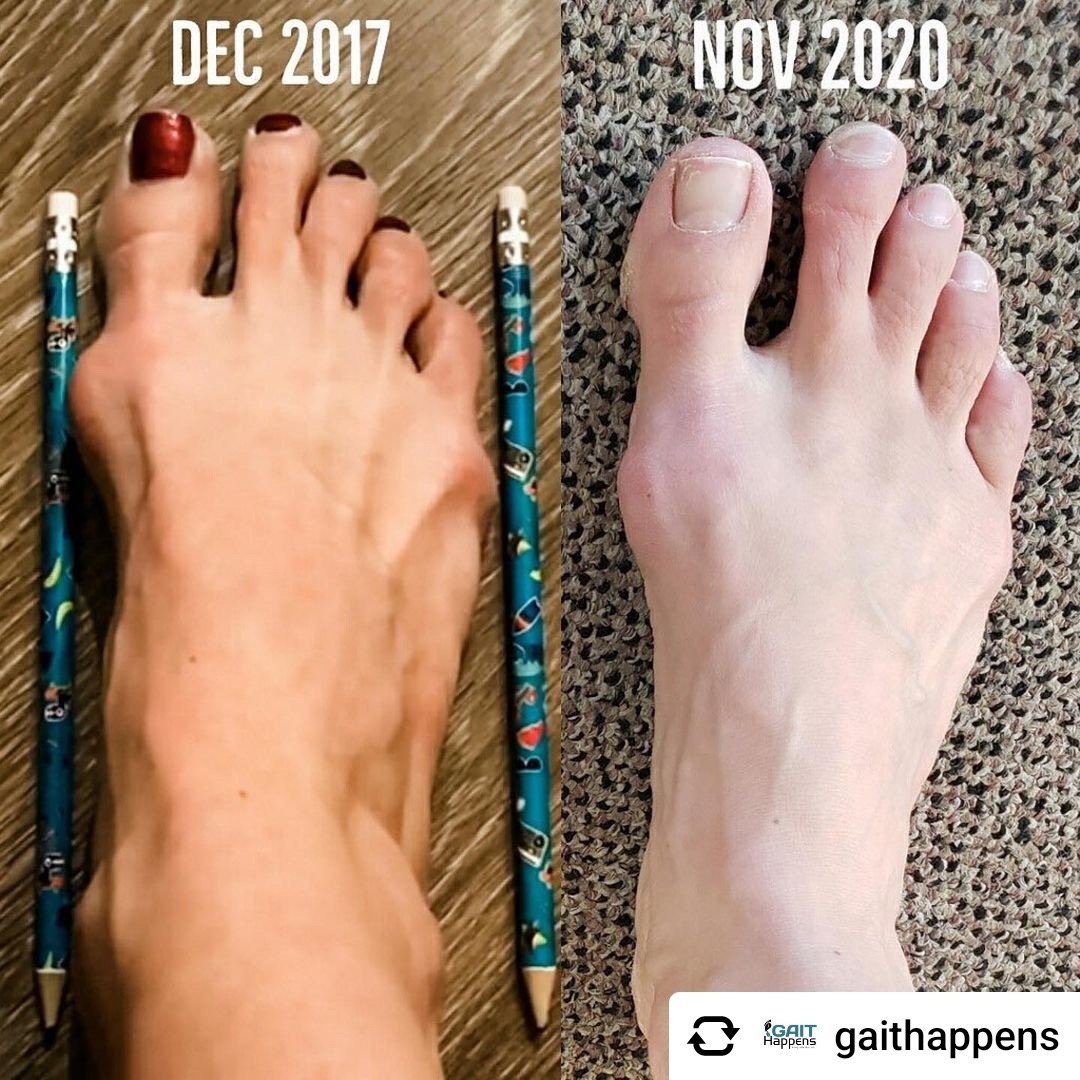
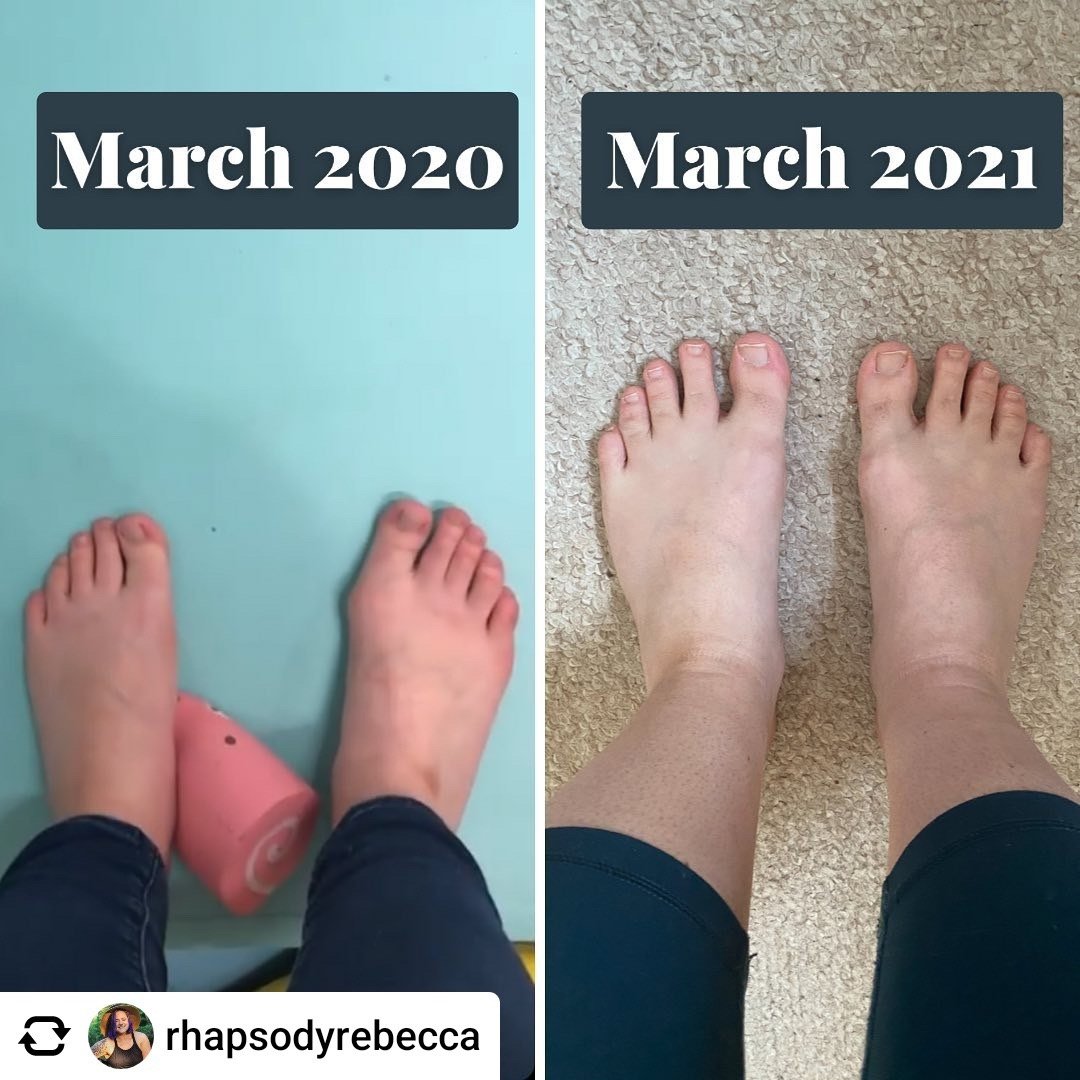

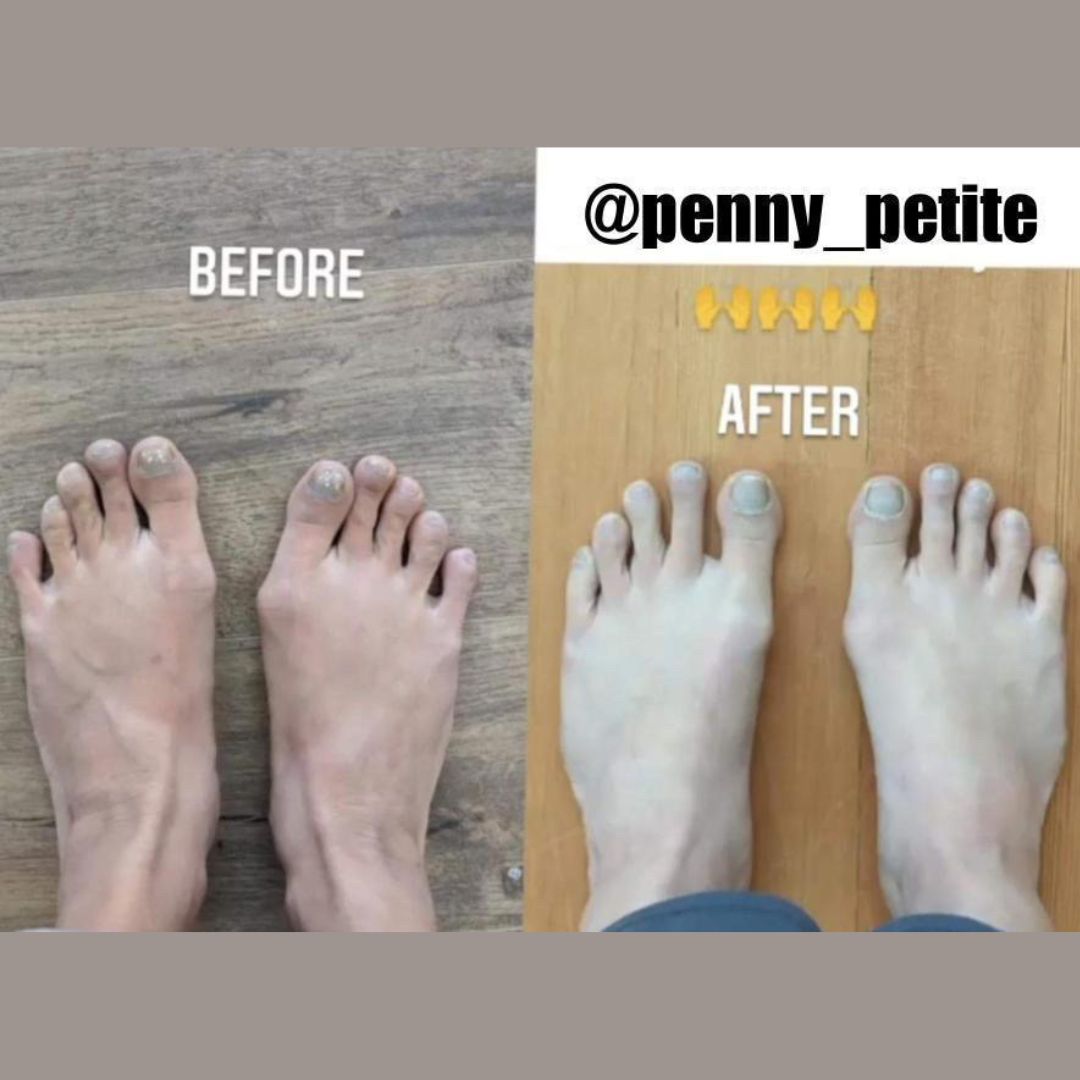
Conclusion
As you can see, a bunion is much more than a gift from your parents. Which means there are things you can do about it! The steps in this article can help you improve the symptoms of your bunion and prevent further damage. Even if you have no visible bunion, your feet and body will benefit from making some simple changes!
Want to work with someone to intentionally rehabilitate your bunion? The Gait Happens Fit Feet program is personalized to help you with your specific foot issues. They are leading experts on foot rehab and offer some of the best remote treatment you’ll find.
About Andy
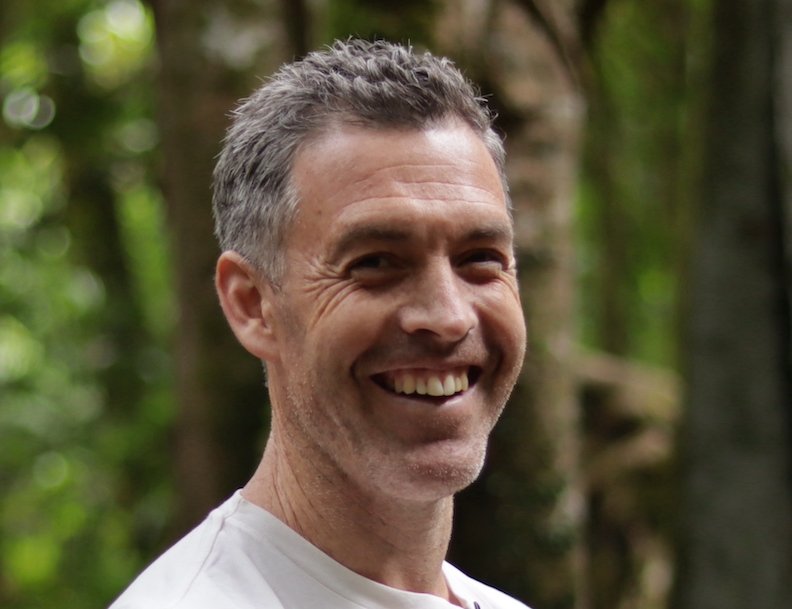
Andy Bryant has been a podiatrist in Melbourne, Australia for 22 years. After a long time of practicing “conventional” podiatry, Andy’s yoga practice intrigued him to consider the potential of the feet to be strengthened. His experiences soon filtered into his clinical practice where he empowers clients with education and tools to look after their feet more naturally.
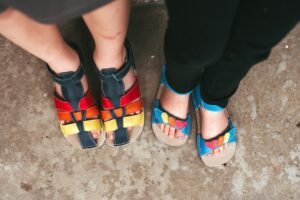


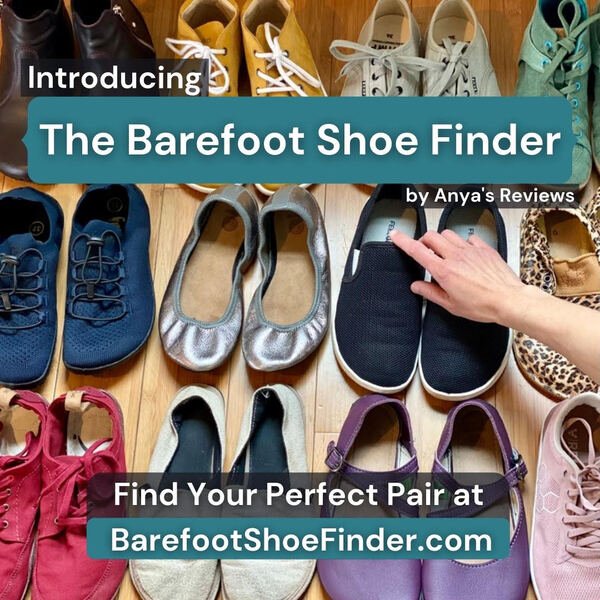
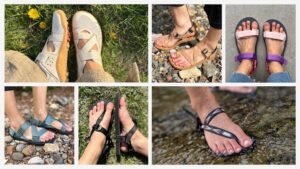
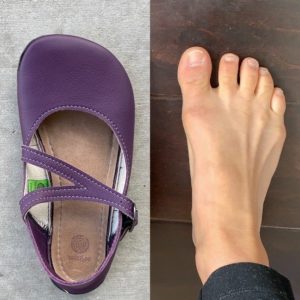


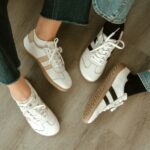




48 thoughts on “How To Help Your Bunions If You Don’t Want Surgery”
Hi Anya, I’m totally new to barefoot shoes and have bunions. I’ve been looking at the Freet Ibex but when I measured my widest foot it is 105mm at the widest point. That would indicate I need a UK size 13, when lengthwise I would go for UK size 7! Could you recommend a wider hiking boot? Many thanks for a fantastic website I’ll be sharing with my simarlily bunion-afflicted daughter.
Thanks SO much for the best articles I have read so far regarding bunions and footwear! I find it very difficult to get footwear that fits my bunions. The shoe is typically too big in the heel if it should be wide enough. Do you have a suggestion for an everyday shoe for long walks with room for hallux valgus? My largest foot measures 23.5 cm (9,3 in) in length and 9.5 cm in width (3,8 in). Pure barefoot shoes won’t work for me as I need a thicker heel.
Thanks in advance,
BR Heidi
I really like the Lems Primal Zen sneaker for bunions – the toe box is really wider and you get volume over the toes too for extra wiggle room. And they have extra cushion.
Hi Anya,
I am new to barefoot shoes like others. I have a big toe bunion and shoes with little cushioning make the balls of my feet sore. At this point I am sometimes carrying my weight on the side of my foot when I walk, opposite the side of my foot with a bunion, due to the discomfort. I do use toe spacers at times when not wearing shoes. My toe shape is plateau. What would your recommendations be for sneakers? Thank you so much for your reply.
Best,
B Young
Sorry to hear you are having pain! It sounds like you need some cushion in your shoes. I would suggest looking at this article on cushioned barefoot shoes. My favorite from that list is the Lems Primal Zen. And you can think about adding your own insole to the barefoot shoes you already have so you don’t have to buy a new pair.
Hi Anya. You’ve converted me into a barefoot believer, so now my kids wear barefoot shoes. But I have a very rare disease called Freiberg’s. My case has improved drastically from pilates and most importantly ditching conventional shoes and switching to exclusively Birkenstock shoes (I don’t mean just sandals) for a decade. I went from being unable to make 3 steps barefoot to this summer being able to walk barefoot even outdoors without the previous side effects. I am very interested in trying barefoot shoes for myself now, but equally scared. Our small community online has little information on the disease, the solution is either a rigid shoe (pain prevention) or surgery. Can you please help us find out wether or not going the barefoot shoe route (along with the strengthening and massaging) could help? Jelena
Not being a clinician I don’t know much about how to go about this, but you can try wide toe box shoes that are more natural than most shoes but also not that different. It can be a less drastic change, while still being kinder to your feet. Many people who are hesitant to try barefoot but want to experience some of the benefits have found good results that way.